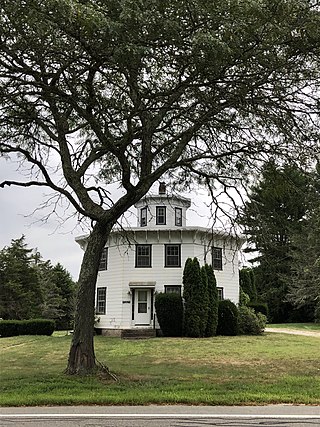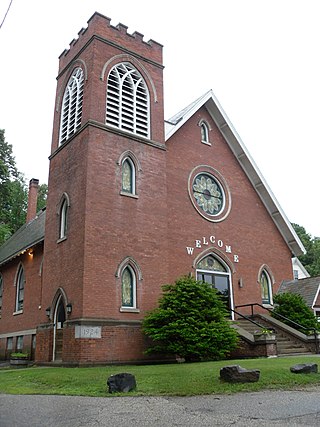
Stagville Plantation is located in Durham County, North Carolina. With buildings constructed from the late 18th century to the mid-19th century, Stagville was part of one of the largest plantation complexes in the American South. The entire complex was owned by the Bennehan, Mantack and Cameron families; it comprised roughly 30,000 acres (120 km2) and was home to almost 900 enslaved African Americans in 1860.
Thomas Franklin Lloyd is one of the founders of Carrboro, North Carolina. He was a prominent North Carolina industrialist who built the Alberta Cotton Mill in 1898 in Carrboro; the former factory building is now home to the Carr Mill Mall.

College Hill is a neighborhood in the west central section of the United States city of Greensboro, North Carolina. College Hill was Greensboro's first neighborhood.

W.T. Blackwell & Co. Tobacco was a tobacco manufacturer in Durham, North Carolina. It was best known as the original producer of Bull Durham Tobacco, the first nationally marketed brand of tobacco products in the United States. The Blackwell tobacco factory in Durham, built in 1874, was declared a National Historic Landmark in 1977. It is included in the American Tobacco Company Manufacturing Plant historic district, and is now occupied by apartments.

Carolina is a village that straddles the border of the towns of Charlestown and Richmond on the Pawcatuck River in Washington County, Rhode Island, United States. Rhode Island Route 112 passes through the village. Carolina is identified as a census-designated place, with a population of 970 at the 2010 census.

Saylesville is a village and historic district in Lincoln, Rhode Island, United States.

This list includes properties and districts listed on the National Register of Historic Places in Durham County, North Carolina. Click the "Map of all coordinates" link to the right to view an online map of all properties and districts with latitude and longitude coordinates in the table below.

The Troy Village Historic District is a historic district encompassing the historic village center of Troy, New Hampshire, United States. The district is centered along New Hampshire Route 12, north to Marlborough Road and south to the junction with South Main Street. To the east of NH 12 it includes School Street, Mill Street, and Monadnock Street as far as Mill Street, and most of the abutting streets. On the west side it includes Russell, Water, and Prospect streets, and South Main Street nearly to Longmeadow Drive. It was listed on the National Register of Historic Places in 2002.

Kendall Mill Historic District is a historic mill complex, mill village, and national historic district located at Camden, Kershaw County, South Carolina. The district encompasses 119 contributing buildings, 1 contributing sites, and 1 contributing structure in Camden. The district is centered on the Wateree Plant and associated structures that date from 1899 to 1923. The mill village to the south and southeast of the plant was built between 1900 and ca. 1925 and is a virtually intact reminder of the importance of the textile industry to South Carolina. The mill faces Kendall Park, a ten-acre landscaped park. On the eastern border of the park are the mill supervisors’ houses, built between 1900 and ca. 1925. The operatives house consist of one-story, 1 1/2-story, and a few two-story frame houses which date from 1900 to 1923. The district also includes Kendall Lake, north of the mill. The Dekalb Cotton Mill was organized in 1899. The Dekalb Mill building, designed by W.B. Smith Whaley in the Romanesque Revival style, was considered a model of textile architecture. The original plant building is a four-story rectangular brick building with a back stair tower and an imposing six-story front stair tower. The west addition to the plant, which is in keeping, architecturally, with the older buildings, was constructed in 1964. It is located in the City of Camden Historic District.
Bellemont Mill Village Historic District is a national historic district located at Bellemont, Alamance County, North Carolina. It encompasses 24 contributing buildings built between 1879 and 1880 in Bellemont. The district includes the three-story brick Bellemont Cotton Hill and 23 associated one and two-story frame mill houses.
Durham Hosiery Mill No. 15, also known as Mebane Yarn Mills, Inc. and Rockfish-Mebane Yarn Mills, Inc., is a historic hosiery mill building located at Mebane, Alamance County, North Carolina. It was built in 1922, and is a two-story, 20-bay, cast-in-place concrete mill building. Two-story concrete pilasters define each window bay. It features a centrally-placed, two-story, projecting square tower. A nine bay addition was built in 1966. The mill closed in 2001.

Erlanger Mill Village Historic District is a national historic district located at Lexington, Davidson County, North Carolina, USA. The district encompasses 282 contributing buildings and 7 contributing structures in a predominantly residential section of Lexington. The mill village dwellings were built between about 1916 and 1929 and include notable examples of Bungalow / American Craftsman style architecture. The dwellings were constructed by the Erlanger Mill Company as worker's housing and in a subdivision designed by noted landscape architect Earle Sumner Draper (1893–1994). The mill itself is a complex of one- and two-story mill buildings constructed from 1913 through the 1960s. Also located in the district are the Erlanger Baptist Church (1936) and Erlanger Graded School.

Kinchen Holloway House, also known as Guess Mill House, is a historic home located at Durham, Durham County, North Carolina. It was built about 1870, and is a two-story, three-bay, frame I-house with a one-story, gable-roof rear ell. It was built by Kinchen Holloway, a farmer and miller.

Durham Cotton Mills Village Historic District are a set of historic mill village houses and national historic district located at Durham, Durham County, North Carolina. The district encompasses 15 contributing residential buildings built by the Durham Cotton Manufacturing Company. They are 1+1⁄2-story, "story and a jump" gable end frame dwellings dated to the mid-1880s. Twelve of the dwellings have rear one-story, gable-roofed ells.

Durham Hosiery Mill is a historic textile mill complex located at Durham, Durham County, North Carolina. It includes seven contributing brick buildings in the complex. The original Durham Hosiery Mill was built in 1902, and consists of a four-story main building with a six-story Romanesque Revival-style tower in front; engine, boiler, and heater houses attached at the rear, and a one-story dye house. The main building was expanded with a two-story annex in 1904, and a three-story annex in 1906. Other buildings include the triangular Annex No. 1 (1912) and a three-story brick finishing building. By 1910, the Durham Hosiery Mills Corporation was the largest manufacturer of cotton hosiery in the world. The mill was abandoned in 1922.

Erwin Cotton Mills Company Mill No. 1 Headquarters Building, also known as Erwin Square, is a historic textile mill complex located at Durham, Durham County, North Carolina. The mill was built in 1892, and is a two-story, 748 feet long, brick building. It features three square towers projecting from the east facade and hundreds of large and closely spaced windows. The building exemplifies "slow burn" construction with its exterior load bearing brick walls and its heavy timber heart pine beams and columns. The headquarters building is a Late Victorian style brick building built in 1892 and enlarged in 1896 and 1905. Attached to the headquarters building is a warehouse. In 1983–1984, the complex was renovated as offices and apartments.

West Durham Historic District is a national historic district located at Durham, Durham County, North Carolina. The district encompasses 101 contributing buildings in a mixed industrial, commercial, and residential section of Durham. The buildings primarily date after 1892 and include notable examples of Classical Revival, Italianate, and Queen Anne architecture. Located in the district is the separately listed Erwin Cotton Mills Company Mill No. 1 Headquarters Building. Other notable buildings include Erwin Cotton Mills Co. Mill No. 4 (1909–10), Erwin Cotton Mills Co. worker's housing (1910s), Fidelity Bank (1920s), E. K. Powe School (1928), Blacknall Memorial Presbyterian Church (1923), and St. Joseph's Episcopal Church.

Oakdale Cotton Mill Village is a historic textile mill, mill village, and national historic district located at Jamestown, Guilford County, North Carolina, United States. The district encompasses 37 contributing buildings including the Logan Manufacturing Company complex built during the 1880s and 33 frame mill worker houses dated to the early-20th century. The factory complex consists of a three-story rectangular brick office, a one and two-story L-shaped brick factory with a four-story tower and five one-story brick warehouses, a small one-story board-and-batten blacksmith shop, and a polygonal brick smokestack.
Glen Royall Mill Village Historic District is a historic mill town and national historic district located at Wake Forest, Wake County, North Carolina. The district encompasses 82 contributing buildings and 1 contributing site built between about 1900 and 1949. It is located in a residential section of the town of Wake Forest. There are notable examples of Bungalow / American Craftsman style architecture. Located in the district is the separately listed Royall Cotton Mill Commissary. Other notable buildings include the Royall Cotton Mill (1899-1900), the Powell-White House (1909-1910), and pyramidal cottages, triple-A cottages, and shotgun houses.

The Springfield Downtown Historic District encompasses the historic central business district of the town of Springfield, Vermont. Located in a narrow valley on the banks of the Black River, the town's architecture is primarily reflective of its importance as a manufacturing center in the late 19th and early-to-mid 20th centuries, with a cluster of commercial buildings surrounded by residential and industrial areas. It was listed on the National Register of Historic Places in 1983, and enlarged slightly in 1986.




















